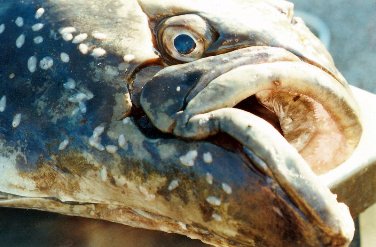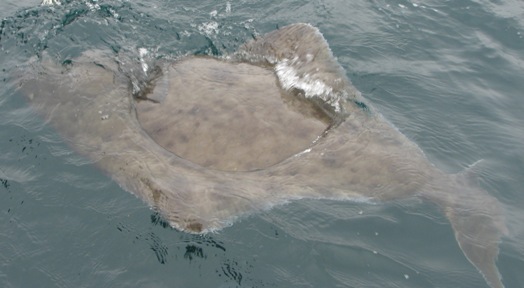Get a Better Look
 Pacific
halibut are longer than most of their relative flatfishes; their width
is about a third of their length.
The tapered head of the halibut houses two independent, telescope eyes
on the right side of its body.
Its eyes are oriented to the side of its "big-lip" jaws so that
its mouth opens laterally when oriented on its side, as it
generally is.
The dark, upper side containing the eyes typically has a uniform grey-brown
hue, but tends to assume the coloration of the sea floor when
found in its natural habitat. The underside is snow white in color, resembling the sky
from below.
Its
exceptional ability to avoid being spotted reduces detection by
prey and predators. Small
scales, smooth to touch, are imbedded in the skin on both sides
of the body.
Pacific
halibut are longer than most of their relative flatfishes; their width
is about a third of their length.
The tapered head of the halibut houses two independent, telescope eyes
on the right side of its body.
Its eyes are oriented to the side of its "big-lip" jaws so that
its mouth opens laterally when oriented on its side, as it
generally is.
The dark, upper side containing the eyes typically has a uniform grey-brown
hue, but tends to assume the coloration of the sea floor when
found in its natural habitat. The underside is snow white in color, resembling the sky
from below.
Its
exceptional ability to avoid being spotted reduces detection by
prey and predators. Small
scales, smooth to touch, are imbedded in the skin on both sides
of the body.
 Unlike
all other vertebrates, the Pacific halibut is not dorso-ventrally orientated, but
rather, laterally.
This adaption has evolved within the order
Pleuronectiformes
to better suit H. stenolepis as a
bottom-dweller.
For the purpose of making anatomical references more clear in
this paragraph, I will refer to the halibut as if it were being
looked at dorso-ventrally, as pictured in black and white above
and to the right. The anal and pelvic fins on the
"ventral" side are merged together to form one long fin that
extends from below the gill slits to the tail. The longer
dorsal fin on the top of the body stretches from the head to the
tail. Each of the two lengthy fins broaden outwards from
the body, coming to a point at the center of the fish, and then
taper off again towards the tail. These elongated,
broadened fins help the flatfish to maintain a lateral balance.
The halibut's pectoral wings on the left and right sides of its
body serve to orient it in the water, while the V-shaped
muscular caudal fin provides most of the thrust.
Unlike
all other vertebrates, the Pacific halibut is not dorso-ventrally orientated, but
rather, laterally.
This adaption has evolved within the order
Pleuronectiformes
to better suit H. stenolepis as a
bottom-dweller.
For the purpose of making anatomical references more clear in
this paragraph, I will refer to the halibut as if it were being
looked at dorso-ventrally, as pictured in black and white above
and to the right. The anal and pelvic fins on the
"ventral" side are merged together to form one long fin that
extends from below the gill slits to the tail. The longer
dorsal fin on the top of the body stretches from the head to the
tail. Each of the two lengthy fins broaden outwards from
the body, coming to a point at the center of the fish, and then
taper off again towards the tail. These elongated,
broadened fins help the flatfish to maintain a lateral balance.
The halibut's pectoral wings on the left and right sides of its
body serve to orient it in the water, while the V-shaped
muscular caudal fin provides most of the thrust.

The picture on the left shows a halibut's head as it is being pulled out of the water. As you can see, the eyes are oriented to the right side of its mouth due to its unique development. The photo on the right depicts the colored, right side of the fish as it emerges from the water. Special thanks to Captain Andrew Mezirow for the images.
Go on to learn more about the behavior of the Pacific halibut.